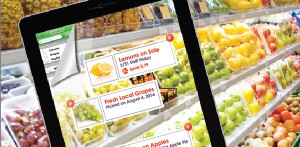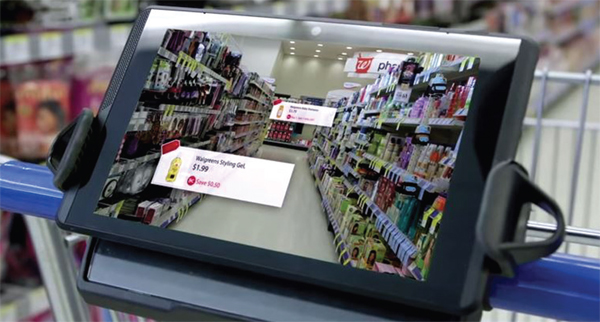By Retail News Insider
 Technology can be fleeting. Sometimes an idea that seems like it would be a hit with consumers turns out to be nothing more than a passing fad. So it’s no surprise that when a new retail technology comes around, many wonder if it’s just a gimmick—or if it could have real staying power. Augmented reality (AR) is a prime example of one of those emerging technologies that some question, while others bet on it being the next big thing.
Technology can be fleeting. Sometimes an idea that seems like it would be a hit with consumers turns out to be nothing more than a passing fad. So it’s no surprise that when a new retail technology comes around, many wonder if it’s just a gimmick—or if it could have real staying power. Augmented reality (AR) is a prime example of one of those emerging technologies that some question, while others bet on it being the next big thing.
Before we can debate that point, however, we have to establish exactly what AR is. In technical terms, it’s the use of technology to change your perception of the environment. Put more simply, it’s taking a computer-generated image and layering it on top of your view of the real world—often as seen through the screen of a smartphone or tablet. Think of pointing your phone at the cover of a magazine and having the model spring to life on the screen and start walking around and talking to you. That’s AR.
“It’s not just editing a photograph of the real world. Nor is it completely immersing yourself in a computerized world, like a video game,” explains Giovanni DeMeo, Vice President of Global Marketing and Analytics for Interactions. “Instead, it’s bringing the content into the environment around you.”
So is there a practical use for AR, or is it all just fancy marketing? Let’s let the evidence do the talking. Here’s a look how five big-name retailers are using AR today to enhance the retail environment.
1. Expanding reach—without expanding footprint
“One of the best uses of AR in retail today is in expanding business to new locations without having to actually build any new physical locations or pay for real estate,” says Abhi Beniwal, Senior Vice President of Global IT for Interactions.
China’s largest online grocer, Yihaodian (51 percent owned by Wal-Mart), is leading the pack in this arena. It’s using AR to bring its products to the people where they live, work and play—without building a single store. The retailer has set up 1,000 “virtual” stores in parking lots, parks and in front of famous landmarks. These stores are completely invisible to passersby who aren’t connected to a mobile device. But bring up the Yihaodian app on your smartphone and suddenly you’ll be able to see an entire grocery store through your screen. Shoppers can walk through the virtual aisles, selecting items simply by tapping on the screens of their devices, then arranging to have their groceries delivered directly to their homes when they’re done.
Click on the video above to see the Yihaodian AR app in action!
2. Improving productivity and availability
AR can also play a role in behind-the-scenes productivity and product availability, as U.K. retailer Tesco is proving with its adoption of a merchandise auditing app created by IBM. To verify whether items are in the right places and if any items are out-of-stock, Tesco associates hold up a tablet to a section of shelves. The tablet instantly checks the image of the shelf against merchandising planograms. If items are out of place or missing, red warning flags appear to pop up on or around the products. Associates can then click on the flag to see what should be in that spot and correct the problem or report it to management right away if, for example, additional inventory is needed.
This enables Tesco to ensure it has the right products in the right places more quickly and efficiently—and can also reduce potential lost sales due to out-of-stocks that might otherwise go unnoticed.
“You’re going to see more of this type of use of AR in the future as brick-and-mortars compete with online and work to become more efficient,” predicts Beniwal.
3. Enriching the shopping experience
Going back to the consumer-facing side of things, American Apparel is showing how AR can be used to enrich the shopping experience inside the store and provide information and options to help clinch—or save—the sale.
The clothing retailer has introduced an app that allows shoppers using their mobile devices to see how items on the rack would look in different colors. If a shopper sees a sweater she loves the look of, but isn’t fond of the color—she can point her phone at the product display and watch the sweater change colors before her eyes. At the same time, options to view customer reviews and additional product details—and to buy the sweater online in the color and size of her choice—pop up alongside the display.
4. Increasing conversion while minimizing returns
With its ability to allow users to see products beyond the box or showroom, AR can also boost conversion, while minimizing returns—and unhappy customers.
Furniture retailer Ikea has integrated AR into its catalogs, allowing smartphone and tablet users to see products in their homes before they actually buy them. Consumers start out by placing Ikea’s print catalog where they want to see a piece of furniture. Then they scan the catalog with Ikea’s AR app, choose an item to view and watch as it virtually appears in their home in true-to-life size. Shoppers can view the furniture from different angles and try out different colors. No more arriving home from the store only to find your new couch is too big for your space or the dining room chairs you bought are too short for your table.

Walgreens AR app
Photo courtesy of aisle411
5. Engaging shoppers
Using a mobile device inside the store is becoming more and more common (CFI Group says 41 percent of us do it—up from 21 percent just a year ago). But even if shoppers are using a retailer’s app, they may be more focused on their screens than the products around them. Walgreens is attempting to combat this by adding AR into the mix to help boost shopper engagement.
Shoppers pick up an AR-enabled tablet inside the store, rather than having to supply their own device. When they hold the tablet up to aisles and shelves, items on sale pop out in front them. Special icons for bonus rewards points also hover over certain aisles, encouraging shoppers to browse them and earn the extra points. When a shopper is looking for a particular product, the tablet creates a 3D arrow that tracks along the floor, highlighting the route to follow.
“[With this technology]… the store comes alive,” says Nathan Pettyjohn, CEO for aisle411, the company who designed the app software. “It turns the store into an immersive, game-like experience.”
It seems clear to us that practical uses of AR abound and the future for the technology is bright. “AR allows retailers to change the experience of shoppers within the retail environment,” says DeMeo. “Because of that alone, I believe it’s going to become mainstream in the relative near future. Those retailers who are thinking about it now and testing ways to use it are going to be that much further ahead of their competitors when it does.”

